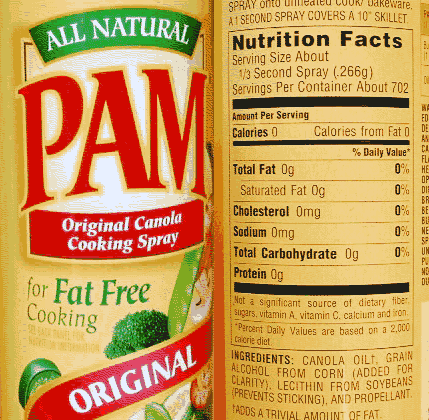Can companies falsely label and incorrectly claim something about a food product?
Although Health Canada and the CFIA are responsible for enforcing food labelling polices, some loopholes are apparent in which some companies try to exploit. A few of these loopholes will be discussed in greater depth a little later, but first we must get an understanding of what these labels stand for.
Listed bellow are food package labels and their respective meanings.
Free - an amount so small that health experts consider it nutritionally insignificant.
Fat free signifies that the product contains less than 0.5 grams per serving.
Sodium free - less than 5 mg sodium per referenced amount(specific amount of food listed in Nutrition Facts).
Cholesterol free indicates that the product has less than 2 mg cholesterol per serving.
Reduced - the product has 25 percent less of a particular substance than the original.
Fat-reduced indicates that the product has 25 percent less fat than the original one.
Reduced in Calories indicates that the product has at least 25 percent less energy than the food it was compared with.
Low - always associated with a very small amount.
Low Fat indicates that the product contains 3 grams of fat or less per serving.
Low in saturated fat signifies 2 grams or less of saturated and trans fat combined per referenced amount.
Source of fibre - 2 grams or more fibre per referenced amount.
Good source of calcium - 165 mg or more of calcium per referenced amount.
As stated earlier, there are loopholes when it comes to food labelling.
Let’s take a look at the food label Light or Lite. The words Light or Lite can refer to the taste, texture, colour, fat content, or caloric content of the food. This specific label is already very generalized. So, how do you know which attribute the words Light or Lite are referring too? This question can be answered by taking a look at the Nutritional Information or Nutrition Fact label, usually located on the back of the product. The next example explains how.
Example #2
Now let us take a look at the label Fat free. As stated above, Fat free signifies that the food product contains 0.5 grams of fat or less per serving. Note the words "per serving."
By looking at the Nutritional Information label located at the back of a particular product one can untangle any confusion that may be associated with the front label. This particular Nutritional Information label of PAM cooking spray indicates that the fat  content of this particular food product is 0 grams per serving. According to Health Canada and the CFIA this product is Fat free. However, taking a closer look at the label, the serving size is only 0.226 grams(an extremely small amount). Because the serving size is so small, it seems as though there is no fat in this product, however, as we all know oil is fat. This product is far from Fat free.
content of this particular food product is 0 grams per serving. According to Health Canada and the CFIA this product is Fat free. However, taking a closer look at the label, the serving size is only 0.226 grams(an extremely small amount). Because the serving size is so small, it seems as though there is no fat in this product, however, as we all know oil is fat. This product is far from Fat free.
Next time you shop, remember that if a product advertises a particular nutritional feature, you can always back up their claim by checking the products Nutritional Information label. This will help ensure that you are getting the product that you are intending to buy.
References
Health Canada. (2002). Nutrition Labelling... Get the Facts! Retrieved June 27, 2009, from http://www.hc-sc.gc.ca/fn-an/label-etiquet/nutrition/educat/te_background-le_point-08-table1-eng.php






